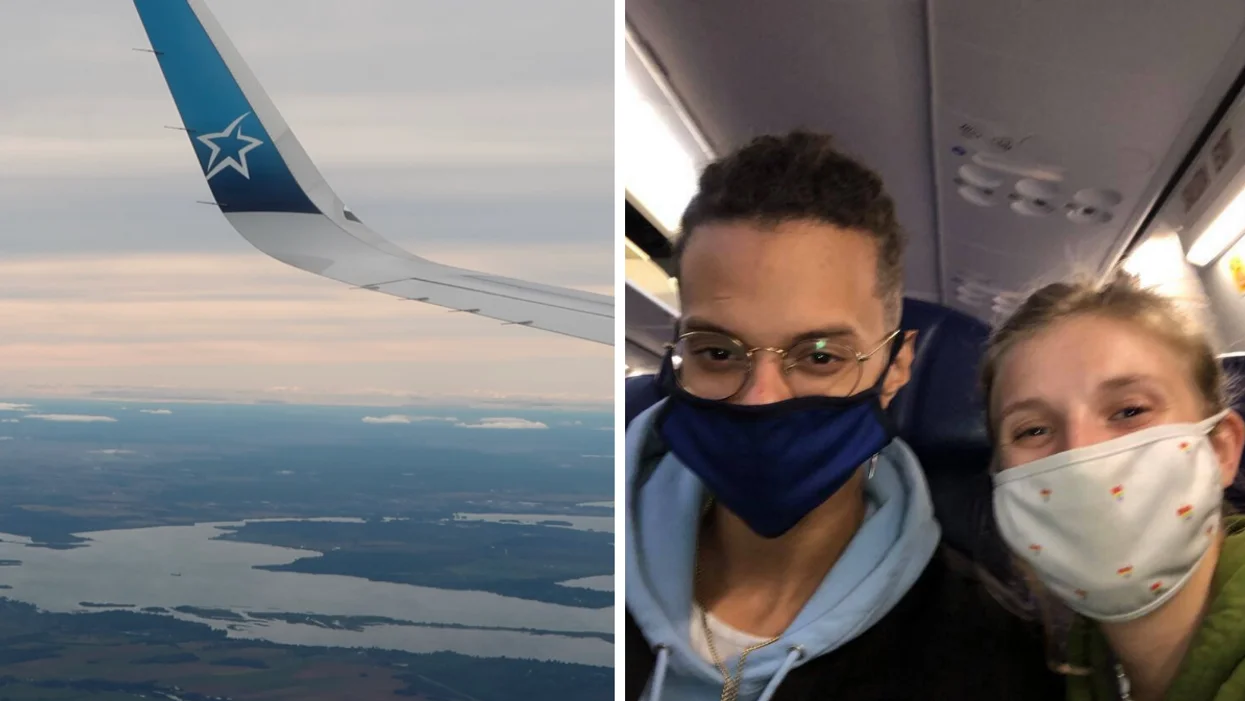What It's Like To Fly Internationally From YUL Right Now, According To Someone Who Did It
What are the rules? Was the airport crowded? How was the flight? ✈️
If you're confused about Canada's evolving COVID-19 travel rules, you're not alone. In fact, new rules came into effect earlier this month when the country began allowing fully vaccinated international travellers to fly into the country for non-essential reasons under certain conditions.
If you're thinking of going somewhere soon, you may be wondering how changes like this have impacted people's trips out of Montreal airport. Is YUL more crowded? Is it stressful? What even are the rules right now?
Narcity Québec reporter Maïlys Kerhoas, a Montreal resident from France, recently flew from Montreal to Mexico with her partner and then, after a 10-day stay, back to Montreal. We asked her to break down the experience so you can get an idea of what it's like for Montreal residents to fly internationally right now.
Since you may be heading somewhere besides Mexico, and each country has different protocols, she focused mainly on the process of returning to Canada.
Is the airport busy?
Kerhoas said the restaurants at YUL were open and crowded.
She also said there was a "huge" line at customs when she got back to Canada, taking her an hour-and-a-half to get through. She'll discuss that in more detail later.
What do you need to do before returning home?
You need to get a COVID-19 test within 72 hours of the scheduled departure time of your flight to Canada, regardless of whether you're vaccinated, Kerhoas explained.
"But be careful. The government does not recognize rapid antigen tests. You will have to get a molecular test, a PCR test. Please note that it will take 24 hours to get the result and that it must be either in English or in French," she said.
When you're budgeting, remember that PCR tests are more expensive than rapid tests. Kerhoas said she paid a "whopping" US$100 for her PCR test.
You also have to fill out information on the ArriveCAN app, which asks questions about how long you've been out of the country, whether you've tested negative for COVID-19, and why you are coming to Canada.
"The app is very intuitive and the questionnaire only takes a few minutes," Kerhoas said.
Once you complete the app questionnaire, you'll get a confirmation code that looks something like "THR0738," she said. You'll also receive the code by email, but Kerhoas suggests taking a screenshot of your ArriveCan application in case you have a hard time connecting to Wi-Fi at customs.
What's the check-in process like?
When she arrived at the Cancun airport, Kerhoas said she went to the kiosk to check in. After that, she had to go to another reception desk where an agent asked her to verify that her PCR test was valid. They also asked if she had downloaded the ArriveCan app.
To get through security, she had to fill out an online document from Mexico confirming she had no COVID-19 symptoms.
To do this, she said she had to use the airport's Wi-Fi.
"I must admit that at this point, I thought that it was complicated to travel for people who don't have a cell phone, especially the elderly," she said.
What's the flight like?
Kerhoas flew with Air Transat. She said the airline gave her a small bag with a surgical mask and hand sanitizer.
"This was very welcome for me, as I really needed to change my mask after several days of travel," she said.
All travellers are required to keep their masks on for the duration of the flight, but Kerhoas said "you will be able to air your nostrils when you drink a glass of water or when you eat your meal."
She also noted that aircraft are disinfected before each flight and sanitary measures are repeated before the safety instructions.
What do you need to do when you arrive in Canada?
"After several hours in the air, you will have to be patient before crossing the border," Kerhoas said.
She explained that the long line at customs was due to border agents checking if people had ArriveCan receipts before progressing in the process. You then have to wait in line to reach the kiosks, where you make your declarations and answer traditional entry questions, she said.
Kerhoas said vaccinated and unvaccinated travellers are separated into two lines because kiosks for unvaccinated travellers are distanced.
"Since Canada is one of the most vaccinated countries in the world, there are more people on that side," she recalled.
You will get a receipt that you have to show to a border agent, who will then ask you some questions, Kerhoas said.
The questions depend on the person. She was asked where she had travelled and why she was coming to Canada. Her boyfriend was asked if he was double vaccinated and what type of vaccine he had received.
"We then picked up our luggage and went home without having to go through quarantine because we were exempted from it," Kerhoas said.
"What I took from the experience is that Canada takes all the necessary measures at the borders to limit the spread of the virus on the territory, which is quite different from some countries like France, my native country, which does not require a PCR test to enter [...] if you are double vaccinated," she said.
"But it is possible to catch COVID-19 even if you have received your two doses."
Before you get going, check out our Responsible Travel Guide so you can be informed, be safe, be smart, and most of all, be respectful on your trip.


